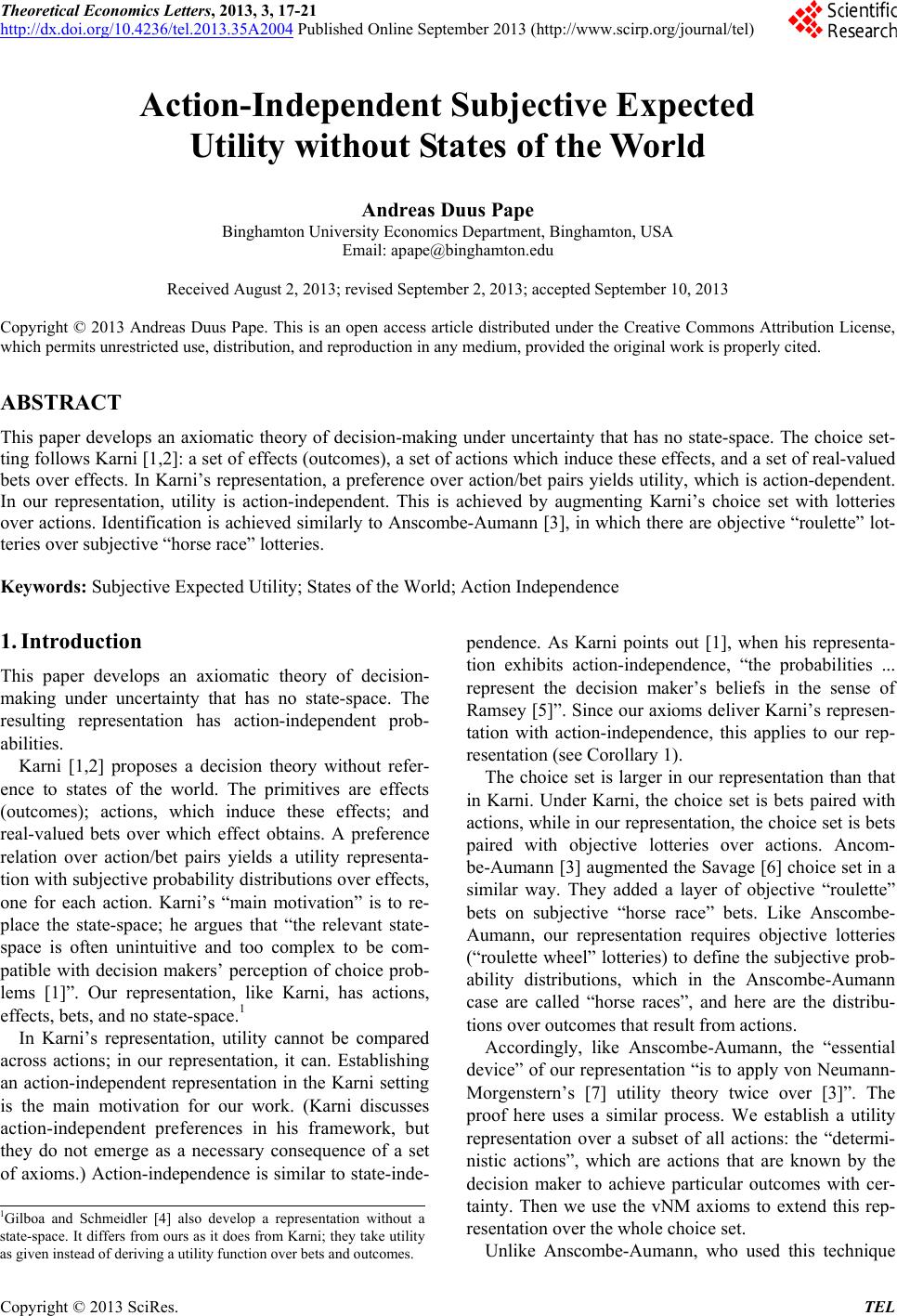 Theoretical Economics Letters, 2013, 3, 17-21 http://dx.doi.org/10.4236/tel.2013.35A2004 Published Online September 2013 (http://www.scirp.org/journal/tel) Action-Independent Subjective Expected Utility without States of the Wo rl d Andreas Duus Pape Binghamton University Economics Department, Binghamton, USA Email: apape@binghamton.edu Received August 2, 2013; revised September 2, 2013; accepted September 10, 2013 Copyright © 2013 Andreas Duus Pape. This is an open access article distributed under the Creative Commons Attribution License, which permits unrestricted use, distribution, and reproduction in any medium, provided the original work is properly cited. ABSTRACT This paper develops an axiomatic theory of decision-making under uncertainty that has no state-space. The choice set- ting follows Karni [1,2]: a set of effects (outcomes), a set of actions which induce these effects, and a set of real-valued bets over effects. In Karni’s representation, a preference over action/bet pairs yields utility, which is action-dependent. In our representation, utility is action-independent. This is achieved by augmenting Karni’s choice set with lotteries over actions. Identification is achieved similarly to Anscombe-Aumann [3], in which there are objective “roulette” lot- teries over subjective “horse race” lotteries. Keywords: Subjective Expected Utility; States of the World; Action Independence 1. Introduction This paper develops an axiomatic theory of decision- making under uncertainty that has no state-space. The resulting representation has action-independent prob- abilities. Karni [1,2] proposes a decision theory without refer- ence to states of the world. The primitives are effects (outcomes); actions, which induce these effects; and real-valued bets over which effect obtains. A preference relation over action/bet pairs yields a utility representa- tion with subjective probability distributions over effects, one for each action. Karni’s “main motivation” is to re- place the state-space; he argues that “the relevant state- space is often unintuitive and too complex to be com- patible with decision makers’ perception of choice prob- lems [1]”. Our representation, like Karni, has actions, effects, bets, and no state-space.1 In Karni’s representation, utility cannot be compared across actions; in our representation, it can. Establishing an action-independent representation in the Karni setting is the main motivation for our work. (Karni discusses action-independent preferences in his framework, but they do not emerge as a necessary consequence of a set of axioms.) Action-independence is similar to state-inde- pendence. As Karni points out [1], when his representa- tion exhibits action-independence, “the probabilities ... represent the decision maker’s beliefs in the sense of Ramsey [5]”. Since our axioms deliver Karni’s represen- tation with action-independence, this applies to our rep- resentation (see Corollary 1). The choice set is larger in our representation than that in Karni. Under Karni, the choice set is bets paired with actions, while in our representation, the choice set is bets paired with objective lotteries over actions. Ancom- be-Aumann [3] augmented the Savage [6] choice set in a similar way. They added a layer of objective “roulette” bets on subjective “horse race” bets. Like Anscombe- Aumann, our representation requires objective lotteries (“roulette wheel” lotteries) to define the subjective prob- ability distributions, which in the Anscombe-Aumann case are called “horse races”, and here are the distribu- tions over outcomes that result from actions. Accordingly, like Anscombe-Aumann, the “essential device” of our representation “is to apply von Neumann- Morgenstern’s [7] utility theory twice over [3]”. The proof here uses a similar process. We establish a utility representation over a subset of all actions: the “determi- nistic actions”, which are actions that are known by the decision maker to achieve particular outcomes with cer- tainty. Then we use the vNM axioms to extend this rep- resentation over the whole choice set. 1Gilboa and Schmeidler [4] also develop a representation without a state-space. It differs from ours as it does from Karni; they take utility as given instead of deriving a utility function over bets and outcomes.Unlike Anscombe-Aumann, who used this technique C opyright © 2013 SciRes. TEL 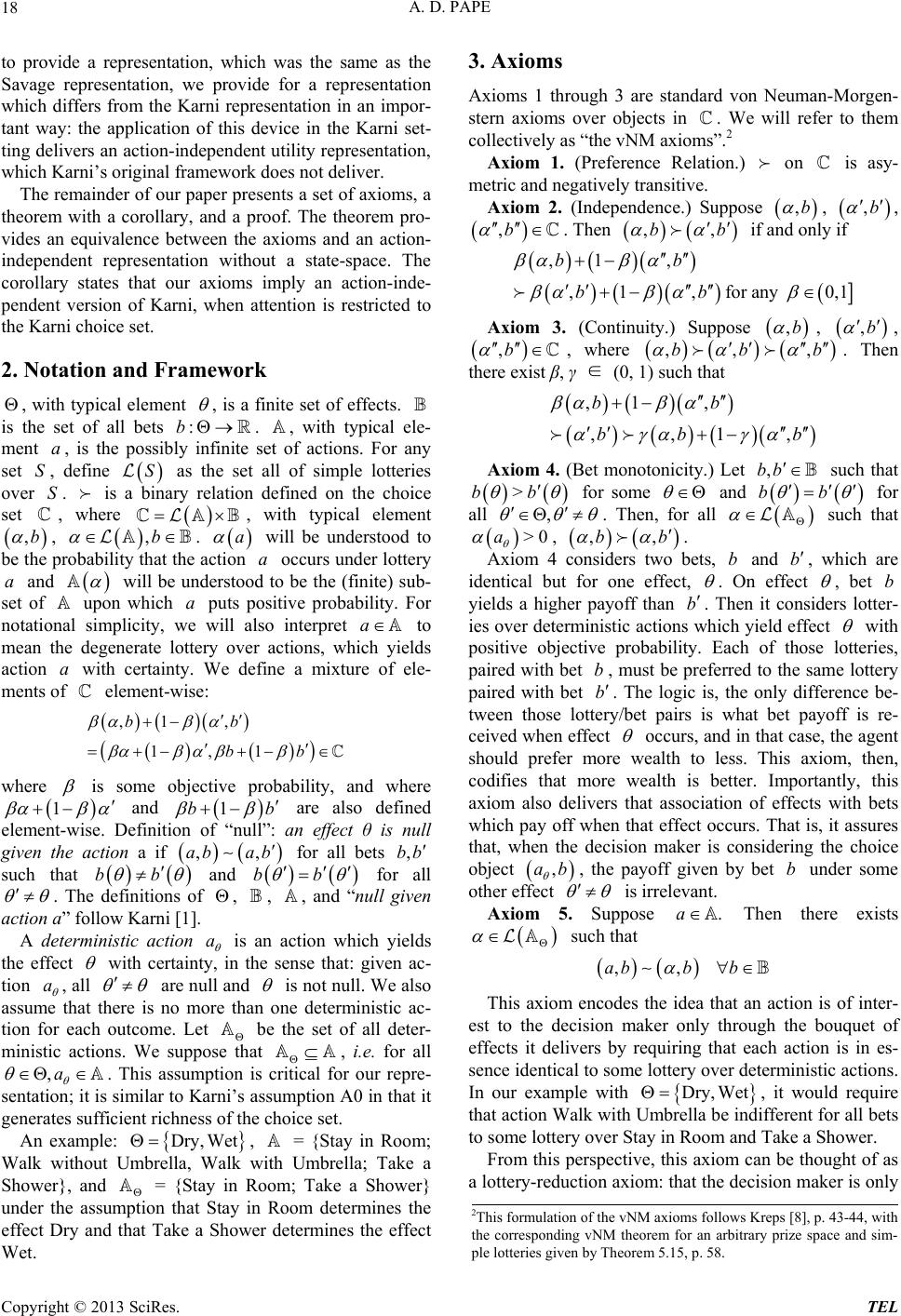 A. D. PAPE 18 to provide a representation, which was the same as the Savage representation, we provide for a representation which differs from the Karni representation in an impor- tant way: the application of this device in the Karni set- ting delivers an action-independent utility representation, which Karni’s original framework does not deliver. The remainder of our paper presents a set of axioms, a theorem with a corollary, and a proof. The theorem pro- vides an equivalence between the axioms and an action- independent representation without a state-space. The corollary states that our axioms imply an action-inde- pendent version of Karni, when attention is restricted to the Karni choice set. 2. Notation and Framework , with typical element , is a finite set of effects. is the set of all bets . , with typical ele- ment , is the possibly infinite set of actions. For any set , define :b a S S ,b as the set all of simple lotteries over . is a binary relation defined on the choice set , where , with typical element , . S b, a will be understood to be the probability that the action occurs under lottery and a a will be understood to be the (finite) sub- set of upon which a puts positive probability. For notational simplicity, we will also interpret a to mean the degenerate lottery over actions, which yields action with certainty. We define a mixture of ele- ments of element-wise: a ,1 , 1,1 bb bb where is some objective probability, and where 1 b and are also defined element-wise. Definition of “null”: an effect θ is null given the action a if 1b ,,ab ab for all bets ,bb such that bb b and b for all . The definitions of , , , and “null given action a” follow Karni [1]. A deterministic action a is an action which yields the effect with certainty, in the sense that: given ac- tion a , all are null and is not null. We also assume that there is no more than one deterministic ac- tion for each outcome. Let be the set of all deter- ministic actions. We suppose that , i.e. for all ,a . This assumption is critical for our repre- sentation; it is similar to Karni’s assumption A0 in that it generates sufficient richness of the choice set. An example: , = {Stay in Room; Walk without Umbrella, Walk with Umbrella; Take a Shower}, and = {Stay in Room; Take a Shower} under the assumption that Stay in Room determines the effect Dry and that Take a Shower determines the effect Wet. Dry, Wet 3. Axioms Axioms 1 through 3 are standard von Neuman-Morgen- stern axioms over objects in . We will refer to them collectively as “the vNM axioms”.2 Axiom 1. (Preference Relation.) on is asy- metric and negatively transitive. Axiom 2. (Independence.) Suppose , ,b ,b , ,b . Then ,,b b if and only if ,1 , ,1,for any 0,1 bb bb Axiom 3. (Continuity.) Suppose , ,b ,b , ,b , where ,,bb ,b. Then there exist β, γ ∈ (0, 1) such that ,1 , ,,1 bb bb ,b Axiom 4. (Bet monotonicity.) Let such that ,bb >bb for some and bb for all , . Then, for all such that >0a , bb,, . Axiom 4 considers two bets, and b, which are identical but for one effect, b . On effect , bet yields a higher payoff than . Then it considers lotter- ies over deterministic actions which yield effect b b with positive objective probability. Each of those lotteries, paired with bet , must be preferred to the same lottery paired with bet b b . The logic is, the only difference be- tween those lottery/bet pairs is what bet payoff is re- ceived when effect occurs, and in that case, the agent should prefer more wealth to less. This axiom, then, codifies that more wealth is better. Importantly, this axiom also delivers that association of effects with bets which pay off when that effect occurs. That is, it assures that, when the decision maker is considering the choice object ,ab , the payoff given by bet under some other effect b is irrelevant. Axiom 5. Suppose Then there exists .a such that ,, abb b This axiom encodes the idea that an action is of inter- est to the decision maker only through the bouquet of effects it delivers by requiring that each action is in es- sence identical to some lottery over deterministic actions. In our example with Dry, Wet , it would require that action Walk with Umbrella be indifferent for all bets to some lottery over Stay in Room and Take a Shower. From this perspective, this axiom can be thought of as a lottery-reduction axiom: that the decision maker is only 2This formulation of the vNM axioms follows Kreps [8], p. 43-44, with the corresponding vNM theorem for an arbitrary prize space and sim- le lotteries given by Theorem 5.15, p. 58. Copyright © 2013 SciRes. TEL 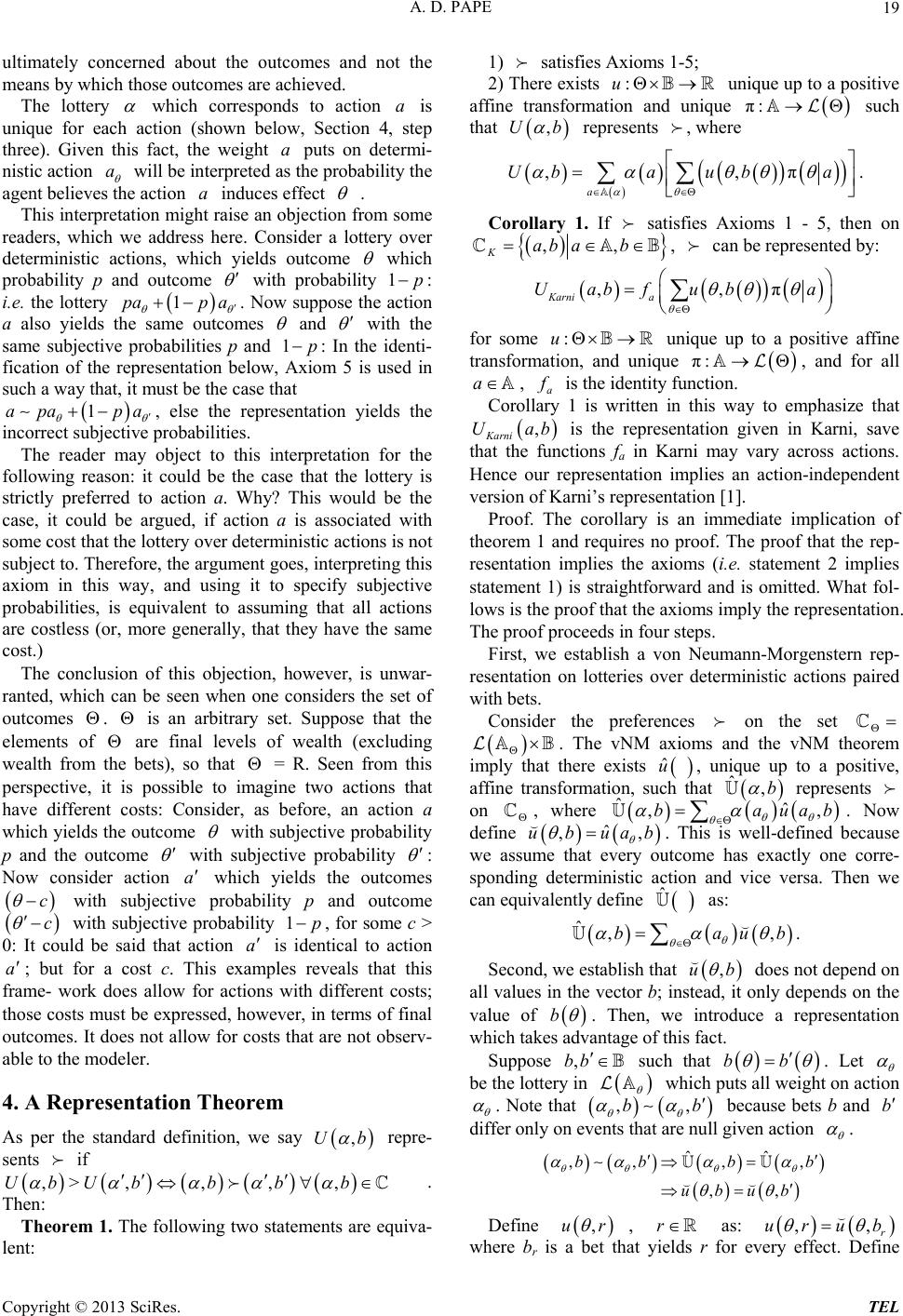 A. D. PAPE 19 ultimately concerned about the outcomes and not the means by which those outcomes are achieved. The lottery which corresponds to action a is unique for each action (shown below, Section 4, step three). Given this fact, the weight puts on determi- nistic action a a will be interpreted as the probability the agent believes the action induces effect a . This interpretation might raise an objection from some readers, which we address here. Consider a lottery over deterministic actions, which yields outcome which probability p and outcome with probability 1p : i.e. the lottery 1pap a . Now suppose the action a also yields the same outcomes and with the same subjective probabilities p and : In the identi- fication of the representation below, Axiom 5 is used in such a way that, it must be the case that 1p 1apa pa , else the representation yields the incorrect subjective probabilities. The reader may object to this interpretation for the following reason: it could be the case that the lottery is strictly preferred to action a. Why? This would be the case, it could be argued, if action a is associated with some cost that the lottery over deterministic actions is not subject to. Therefore, the argument goes, interpreting this axiom in this way, and using it to specify subjective probabilities, is equivalent to assuming that all actions are costless (or, more generally, that they have the same cost.) The conclusion of this objection, however, is unwar- ranted, which can be seen when one considers the set of outcomes . is an arbitrary set. Suppose that the elements of are final levels of wealth (excluding wealth from the bets), so that = R. Seen from this perspective, it is possible to imagine two actions that have different costs: Consider, as before, an action a which yields the outcome with subjective probability p and the outcome with subjective probability : Now consider action which yields the outcomes with subjective probability p and outcome with subjective probability 1, for some c > 0: It could be said that action is identical to action ; but for a cost c. This examples reveals that this frame- work does allow for actions with different costs; those costs must be expressed, however, in terms of final outcomes. It does not allow for costs that are not observ- able to the modeler. a c c a p a 4. A Representation Theorem As per the standard definition, we say repre- sents if . Then: ,Ub ,b ,>Ub ,, ,U bbb Theorem 1. The following two statements are equiva- lent: 1) satisfies Axioms 1-5; 2) There exists :u unique up to a positive affine transformation and unique π: such that ,Ub represents , where ,,π a Uba uba . Corollary 1. If satisfies Axioms 1 - 5, then on ,, Kab ab, can be represented by: ,,π Karni a Uabfub a for some :u unique up to a positive affine transformation, and unique , and for all π: a , a is the identity function. Corollary 1 is written in this way to emphasize that , Karni Uab is the representation given in Karni, save that the functions fa in Karni may vary across actions. Hence our representation implies an action-independent version of Karni’s representation [1]. Proof. The corollary is an immediate implication of theorem 1 and requires no proof. The proof that the rep- resentation implies the axioms (i.e. statement 2 implies statement 1) is straightforward and is omitted. What fol- lows is the proof that the axioms imply the representation. The proof proceeds in four steps. First, we establish a von Neumann-Morgenstern rep- resentation on lotteries over deterministic actions paired with bets. Consider the preferences on the set . The vNM axioms and the vNM theorem imply that there exists ˆ u, unique up to a positive, affine transformation, such that represents on ,b ˆ , where ˆ ˆ,,bau ab . Now define ,b ˆ ua,ub . This is well-defined because we assume that every outcome has exactly one corre- sponding deterministic action and vice versa. Then we can equivalently define ˆ as: ,,ba u ˆ b . Second, we establish that does not depend on all values in the vector b; instead, it only depends on the value of ,ub b . Then, we introduce a representation which takes advantage of this fact. Suppose ,bb such that bb . Let be the lottery in which puts all weight on action . Note that ,b ,b because bets b and b differ only on events that are null given action . ˆˆ ,,, , ,, bb b ubub b Define ,ur , r as: ,, r urub where br is a bet that yields r for every effect. Define Copyright © 2013 SciRes. TEL 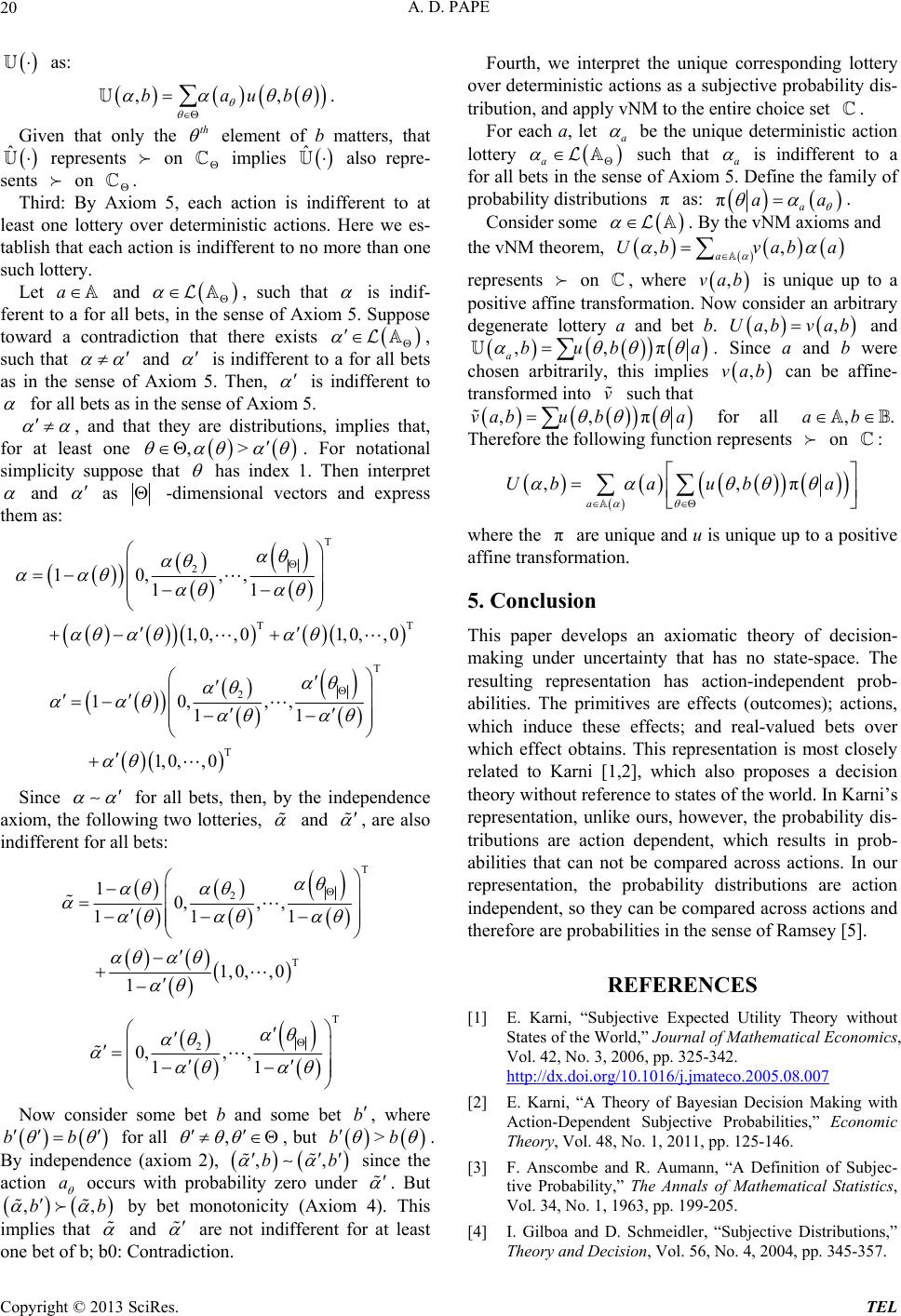 A. D. PAPE 20 as: ,,baub th . Given that only the element of b matters, that represents on implies also repre- sents on . ˆ ˆ Third: By Axiom 5, each action is indifferent to at least one lottery over deterministic actions. Here we es- tablish that each action is indifferent to no more than one such lottery. Let and a , such that is indif- ferent to a for all bets, in the sense of Axiom 5. Suppose toward a contradiction that there exists , such that and is indifferent to a for all bets as in the sense of Axiom 5. Then, is indifferent to for all bets as in the sense of Axiom 5. , and that they are distributions, implies that, for at least one ,> . For notational simplicity suppose that has index 1. Then interpret and as -dimensional vectors and express them as: T 2 T 10,,, 11 1, 0,,01, 0,,0 T T 2 T 10,,, 11 1, 0,, 0 Since for all bets, then, by the independence axiom, the following two lotteries, and , are also indifferent for all bets: T 2 T 10,, , 111 1,0, ,0 1 T 2 0,,, 11 Now consider some bet b and some bet b , where bb for all , , but >bb . By independence (axiom 2), ,b,b since the action a occurs with probability zero under . But ,b ,b by bet monotonicity (Axiom 4). This implies that and are not indifferent for at least one bet of b; b0: Contradiction. Fourth, we interpret the unique corresponding lottery over deterministic actions as a subjective probability dis- tribution, and apply vNM to the entire choice set . For each a, let a be the unique deterministic action lottery a such that a is indifferent to a for all bets in the sense of Axiom 5. Define the family of probability distributions as: π πa aa . Consider some . By the vNM axioms and the vNM theorem, ,, avaba Ub represents on , where ,vab is unique up to a positive affine transformation. Now consider an arbitrary degenerate lottery a and bet b. ,b vab,Ua and a ,,πb abu . Since a and b were chosen arbitrarily, this implies can be affine- transformed into such that ,va b v ,,πvabu b a for all ,.ab Therefore the following function represents on : ,,π a Ubauba where the are unique and u is unique up to a positive affine transformation. π 5. Conclusion This paper develops an axiomatic theory of decision- making under uncertainty that has no state-space. The resulting representation has action-independent prob- abilities. The primitives are effects (outcomes); actions, which induce these effects; and real-valued bets over which effect obtains. This representation is most closely related to Karni [1,2], which also proposes a decision theory without reference to states of the world. In Karni’s representation, unlike ours, however, the probability dis- tributions are action dependent, which results in prob- abilities that can not be compared across actions. In our representation, the probability distributions are action independent, so they can be compared across actions and therefore are probabilities in the sense of Ramsey [5]. REFERENCES [1] E. Karni, “Subjective Expected Utility Theory without States of the World,” Journal of Mathematical Economics, Vol. 42, No. 3, 2006, pp. 325-342. http://dx.doi.org/10.1016/j.jmateco.2005.08.007 [2] E. Karni, “A Theory of Bayesian Decision Making with Action-Dependent Subjective Probabilities,” Economic Theory, Vol. 48, No. 1, 2011, pp. 125-146. [3] F. Anscombe and R. Aumann, “A Definition of Subjec- tive Probability,” The Annals of Mathematical Statistics, Vol. 34, No. 1, 1963, pp. 199-205. [4] I. Gilboa and D. Schmeidler, “Subjective Distributions,” Theory and Decision, Vol. 56, No. 4, 2004, pp. 345-357. Copyright © 2013 SciRes. TEL 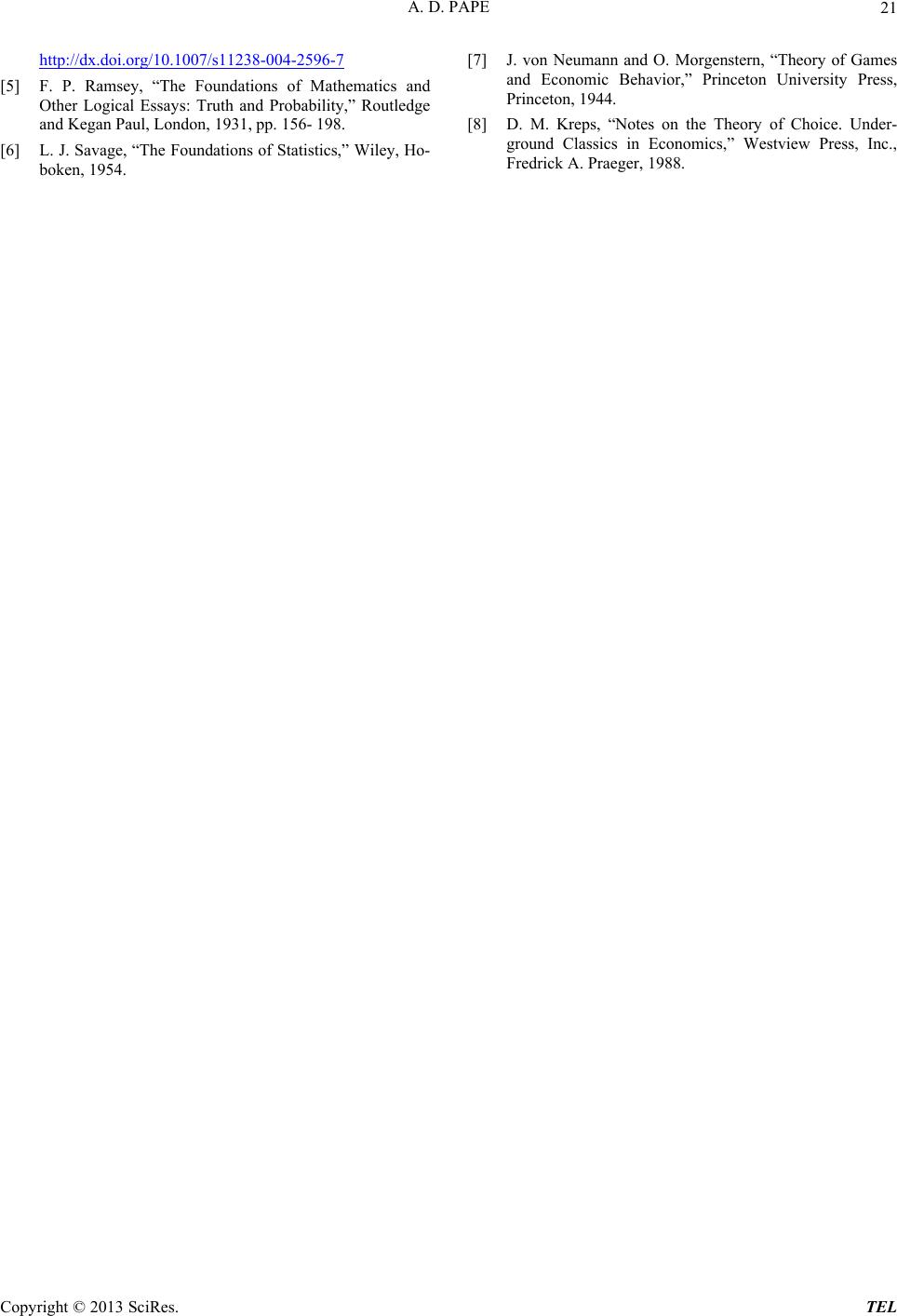 A. D. PAPE Copyright © 2013 SciRes. TEL 21 http://dx.doi.org/10.1007/s11238-004-2596-7 [5] F. P. Ramsey, “The Foundations of Mathematics and Other Logical Essays: Truth and Probability,” Routledge and Kegan Paul, London, 1931, pp. 156- 198. [6] L. J. Savage, “The Foundations of Statistics,” Wiley, Ho- boken, 1954. [7] J. von Neumann and O. Morgenstern, “Theory of Games and Economic Behavior,” Princeton University Press, Princeton, 1944. [8] D. M. Kreps, “Notes on the Theory of Choice. Under- ground Classics in Economics,” Westview Press, Inc., Fredrick A. Praeger, 1988.
|